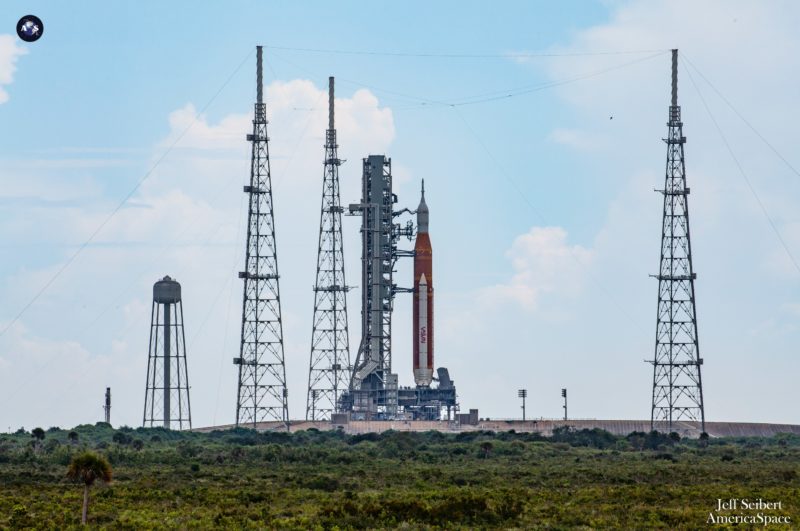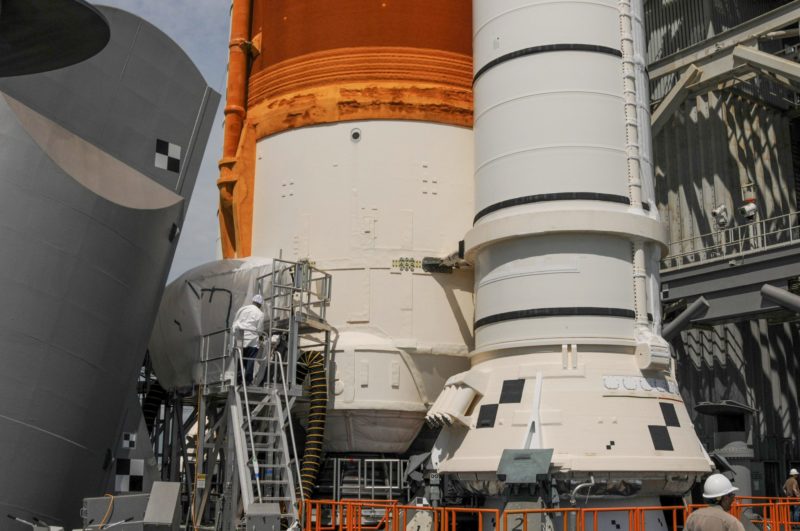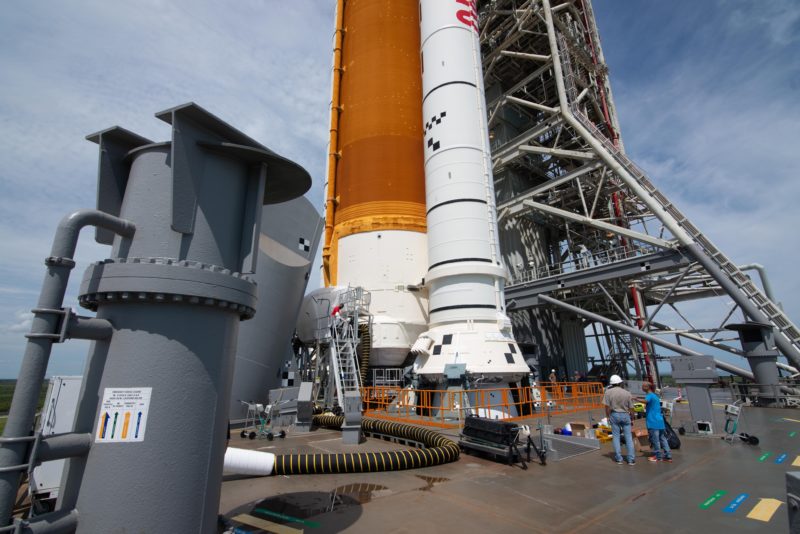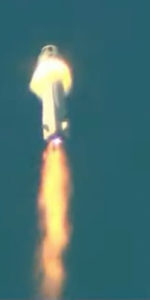
NASA held a media event on September 8, 2022 to discuss the status of Artemis 1. Hosting the event was Kathrine Hambleton, of NASA’s Office of Communications. The event participants were Jim Free, NASA’s Associate Administrator For Exploration Systems Development Directorate, Mike Bolger, Exploration Ground Systems Program Manager at Kennedy Space Center, and John Blevins, SLS Chief Engineer, Marshall Spaceflight Center.
Waivers and Launch Dates
Associate Administrator Jim Free made two opening points. First, he discussed that NASA has applied for a flight waiver from Space Launch Delta 45, which manages the Easter Range, regarding the flight termination system (FTS) batteries. This is to allow for a launch attempt in late September. Following that, he announced the proposed launch dates should the waiver be granted by the Space Force’s Space Launch Delta 45.
Space Force’s Space Launch Delta 45, which manages the Easter Range, required that the FTS be tested 15 days before the scheduled launch, expected to be on August 29. This means that the FTS batteries were activated on August 14. Current flight rules on a launch of Artemis 1 on the Eastern Range limit the FTS batteries to 25 days, after which the batteries would need to be replaced and retested. That allowed a launch up to September 9. NASA’s Artemis 1 team is trying to get a waiver for an additional 2 1/2 weeks on the FTS batteries.
SLS Chief Engineer John Blevins indicated that the waiver request does not bump-up against the replace requirements of the batteries themselves. Some FTS batteries, he said, have been tested under much more arduous conditions than the current Artemis 1’s FTS batteries and for a much longer time than the span in the waiver request.
Jim Free emphasized that Space Launch Delta 45 in general, and its commanding officer Gen. Purdy in particular, have, Jim Free said more than once, been very helpful in working on launch waivers for Artemis 1 to launch towards the end of September.
Brig. General Stephen Purdy holds four titles, (1) Program Executive Officer for Assured Access to Space, Commander, (2) Space Launch Delta 45, (3) Director of Launch and Range Operations, Space Systems Command, and (4) Director of the Eastern Range, Patrick Space Force Base, Florida.
Final discussions between the Artemis 1 launch team and Delta 45 were held on Wednesday and the waiver package was submitted Thursday, September 8.
Jim Free said that, going forward, if NASA is allowed to extend FTS battery test requirements, then there are two possible launch dates, September 23 and 27.
NASA has several rationales for launching on September 23 and 27. The rationale behind the Sept. 23 Launch revolves around NASA trying to deconflict with DART and its needs of the Deep Space Network (DSN). The Artemis office wants to stay outside of the lockdown of DSN for DART. Artemis 1 launching on Sept. 23 means that critical events post initial launch would fall on the other side of the impact of DART’s impact on the DSN on the 26th.
One impact on a September 23 launch is when Space Launch Delta 45 grants, if it in fact does, its waiver on the FTS batteries. There was some disagreement among the media event participants as to how much time would be needed. Associate Administrator Jim Free stated that a September 23 launch requires that there’s a waiver answer before September 22. Meanwhile, KSC Exploration Ground Systems Program Manager Mike Bolger thought that 4 days would be needed.
The September 23 launch date has a 120 minute launch window. The launch time on the 23rd is expected at 6:37 AM, the launch window is 120 minutes, and is expected to land on October 18.
There is another September launch date available on Sept. 27th. This would see Artemis 1 launch on the backside of DART in advance of some other activities on the range set to happen on the 30th. The launch window for this day is 70 minutes and an expected landing on November 5.
A third launch date exists, but it conflicts with the Crew 5 mission. The Artemis 1 team is currently working with Crew 5 program and KSC from a consumables perspective, with other activities on the range with replenishment times for the gaseous nitrogen (GN2) between launches.
Jim Free concluded his opening remarks by stating that Artemis 1 will hold with the September 23 and 27 launch dates, for now.
Removals and Replacements
Next up was Mike Bolger, EGS Manager at Kennedy Space Center. He started-off by noting that after standing down from last Saturday’s last launch attempt, EGS has been busy de-configuring from launch and then working to repair the liquid hydrogen (LH2) leak that cropped-up during tanking.
The repair is to:
- Remove and replace seals on the 8” fill and drain quick-disconnect (QD).
- Remove and replace the seals on the 4” Bleed QD
Both are at the flight to ground interface between LH2 and tail surface mass umbilical, or TSMU, and Core Stage.
To remove and replace the 8″ and 4″ QD seals, they have to de-mate the LH2 TSMU ground plate from the flight plate, to gain access to the QD’s.
A great article on T-0 surface mass umbilicals (SMU’s) during the Shuttle era can be found at, “My Best Mistake: Eugene Hajdaj’s “What Could Go Wrong?”
The umbilical system release is activated by a drop weight. As the weight falls, it retracts the ground half of the umbilical away from the vehicle into the protective housing of the tall service mast by means of cables (called lanyards) attached to the umbilical plate. A set of slightly longer lanyards releases a door called a “bonnet” that falls over the opening in the mast, protecting the systems from the rocket exhaust that passes just a few feet away. Because that second set of lanyards is longer, the bonnet falls just after the umbilical is retracted into the housing.
My Best Mistake: Eugene Hajdaj’s “What Could Go Wrong?” by Eugene Hajdaj
Once the plates are disconnected, the workers install transportation caps on the various lines and a plate cover to protect against contamination while the work is done.
Plate de-mate of the 8″ and 4″ QD’s was completed on Wednesday, September 7 and then inspection of the seals for both lines (8” and 4”) began.
Following the de-mate, an enclosure was setup around the area to protect the hardware from weather and any other environmental conditions while the seal R&R is performed. The enclosure is a plastic tent that covers both the workers and the flight plates on some TSMU access stands that are out on the pad that has incoming conditioned air to keep the environment good for the work that is being done.

The R&R of the 8″ and 4″ QD seals began on the morning of September 8 with the help of Boeing employees. The plan called for completing seal R&R by end of Thursday, Sept. 8. If weather turns bad, that could mean that only the 8” seal is removed and replaced. Once R&R is done, the ground and flight plates will be re-mated in preparation for tanking test scheduled for the weekend of September 10-11.
Cryo-Load Test
After the repairs are completed, there will be a cryogenic, or cryo, loading demo for verification of the 8″ and 4″ seals on September 17 to verify that the seal removal and replacement (R&R) is good. The preliminary cryo loading plan is to load up both the LOX tank (196,000 gal, 741,941 L) and LH2 tank (537,000 gal, 2 million L) full-up on the Core Stage. The cryo-loading team is currently looking at procedures and software in order to determine what that would look like. That could be the long pole toward getting to the test and therefore the launch. There is the possibility that the Sept. 17 cryo test date could slip by a day or two, with minimal impact on the September 23rd or 27th launch attempt.
Some have wondered if the design of the quick disconnects (QD’s) on SLS are different from that found on Shuttle. SLS Chief Engineer said that the QD seals on the Space Shuttle and SLS are similar but not the same. He added that every tanking system is different from volumes, temperatures, pressures, and rates of change. The Space Shuttle and SLS plumbing both on and off the vehicle are different. Associate Administrator Jim Free highlighted Shuttle had these problems ever after 9 years of operations. He noted that Apollo and the commercials launch companies have also had issues the first time you process them.
One thing that that has been discussed with the SLS team, which it brought forward, is a change in the concept of cryo loading operations to reduce pressure and flow changes during tanking, which is being called, “A Kindler and Gentler”, approach to tanking It is hoped that this revised loading process will reduce stress from pulses or sudden changes on the seals.

John Blevins, the SLS Chief Engineer, discussed work on SLS to evaluate the launcher for any life-limited items. A hi-resolution visual inspection along with walk-downs have been performed. The state of the vehicle looks good. The solid motor boosters are good now and have a few more months left in them. John Blevins was encouraged that in the one week since the last scrub a great deal has been done to verify the launch vehicle and address the liquid hydrogen leaks. He said that he feels like there’s a good plan going forward with the changes in processes going forward.
A Pressure Excursion
During the September 3 media event after that day’s launch scrub, it was mentioned that there had been an inadvertent over-pressurization of the 8″ LH2 line. During the September 8th media event, there were several questions about how such an event could happen, whether this event contributed to the leak on the 8″ QD, and what was being done to make sure such an event didn’t occur again.
Exploration Ground Systems Program Manager at Kennedy Space Center Mike Bolger discussed the cause of the inadvertent over-pressurization, or pressurization excursion, and its affects. The over-pressure of the system did not exceed the design capacity for SLS. It is still unknown if that pressure excursion was the cause of the 8” LH2 QD leak because at that time testing was not yet completed and that analysis remained ongoing.
The reason for the inadvertent pressure event was because a wrong valve was manually opened for 2-3 seconds. At that time, just days after the first launch scrub, there had not been a lot of time to write-in automatic procedures on loading because of process changes, so the cryo-loading team had to go manual.
After the scrub on September 3, the management team apologized to the operator on the cryo team because the management team had made some manual procedure changes between the attempt on a Monday and Saturday that prevented relying on automated processes. There had only been a couple of chances in that time period to test this manual process.
We all own the process, especially leadership owns that. As far as I’m concerned, everyone’s finger was on that switch.
Associate Administrator Jim Free on management’s responsibility for the pressure excursion
Associate Administrator Free added in that this issue of insufficient time for the cryo-loading team to get accustomed to revised cryo-loading procedures is being factored into the upcoming tanking test. Artemis management has asked Charlie Blackwell Thompson to make sure that there is enough time for her folks to practice and be prepared for the new loading process. “We all own the process, especially leadership owns that”, said Free, adding that, “As far as I’m concerned, everyone’s finger was on that switch.”
Artemis 1 Mission Manager Mike Sarafin added that it is hoped that the “Kinder and Gentler” loading process will alleviate pressure excursions even with an accidental opening of a wrong valve. One difference is that the “Kindler Gentler” cryo loading has pauses in loading phases between chill-down, slow loading, fast loading.
After the September 3 launch attempt scrub, some outside of NASA wondered if there might be design issues with the quick-disconnects. Others wondered if liquid hydrogen was worth the trouble it has given NASA from the Shuttle through to the Artemis programs? Mike Sarafin stated that hydrogen is worth the pain. It give a rocket engine a high ISP, or performance, of up to 450 seconds. This is one of the reasons that the RS-25 engines, as old as they may be, remain the top performers even today.
What Happens Next?
Should Artemis 1 not be granted a waiver to launch in late September, in order to comply with the current launch rules, NASA will be forced to roll the Artemis 1 launch vehicle back to the Vehicle Assembly Building (VAB).
Some have wondered if another roll would stress the launch vehicle beyond its design. Rolling the launch vehicle induces frequencies of the rolls, and that affects the determination of whether limits of parts have been exceeded. Rolls also induce routine wear and tear, which SLS Chief Engineer Blevins wants to prevent. However, Blevins made clear in answering several questions regarding this that the Artemis 1 launcher has not yet exceeded rolls, roll-out limits, that they won’t be exceeded even with another roll-out and back.
Whenever there is a launch scrub, someone will ask NASA about the cost of scrubs. Jim Free, echoing Nelson, said that the cost of failure is much higher than cost of scrub. So other costs are unimportant. Mike Bolger did note that cryogenic fluids, liquid hydrogen and liquid oxygen, are somewhat recaptured.
NASA’s Artemis 1 Press Kit is available for download and is a great resource.






My birthday is on the 22nd—what a nice present a successful lift off would be…..publiusr